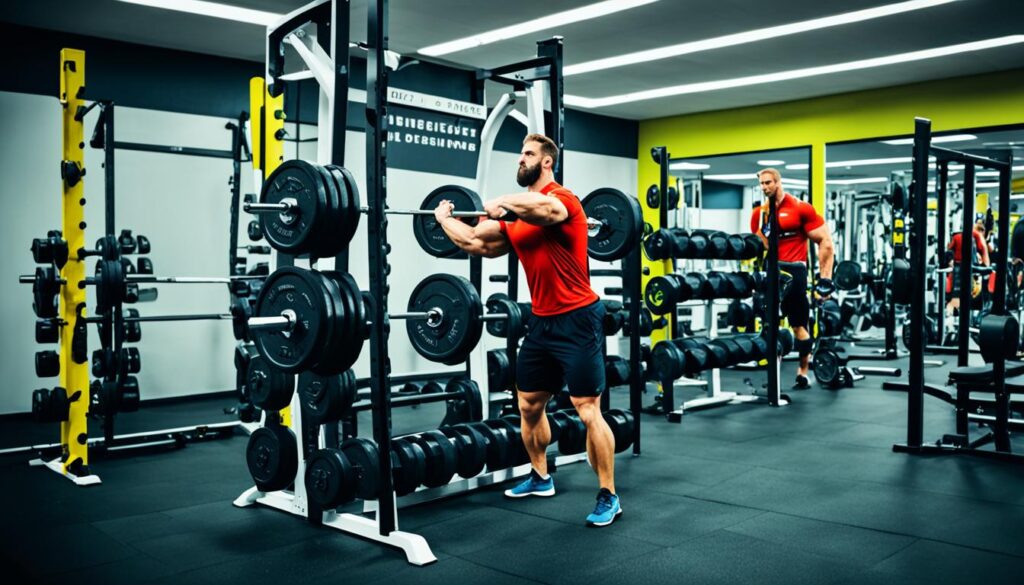Ready to reshape both your body and mind with strength training? This guide for beginners will show you how to make the most out of your fitness journey. Strength training goes beyond just muscle gain. It’s a key to living a healthier, more active life. Come along with us and find out how it can change your life.
Key Takeaways
- Strength training can help fight off muscle loss as we age (known as sarcopenia).1
- It also boosts bone density and cuts down the chances of getting osteoporosis.12
- This kind of exercise speeds up your metabolism, helping you burn more calories, even when resting.12
- It has mental health perks too, making you feel happier, better handling stress, and thinking sharper.1
- For older adults, strength training can make arthritis and moving around easier.1
The Power of Strength Training
Strength training brings many benefits to your body and mind. Doing regular resistance exercises helps grow muscles.3This boosts your strength and fitness. It helps in sports and keeps muscles strong as you get older.
Building Lean, Toned Muscle
Strength training is great for adding lean muscle. You just have to lift heavier over time.3 This makes your muscles bigger and stronger. You get a better body shape and more power.
Increased Bone Density and Strength
Strengthening muscles also helps your bones.4 This is key as we grow older. It lowers the chance of breaking a bone. Weight lifting makes your bones tougher.
Boosted Metabolism and Fat Burning
More muscle means you burn more calories, even when resting.3 This is good for losing weight. You keep burning calories all day, not just when you work out.
| Benefit | Statistical Data |
|---|---|
| Reduced fall risk in older adults | 3 34% reduction in falls among adults over the age of 60 who participated in a well-rounded exercise program including balance exercises and resistance training |
| Reduced injury risk in athletes | 3 33% reduced risk of injury among athletes engaged in strength-training programs |
| Reduced diabetes risk in women | 3 30% reduced risk of developing type 2 diabetes among women who engage in strength training |
| Increased post-workout metabolic rate | 3 72 hours of increased metabolic rate after strength-training exercise |
| Reduced injury risk with increased volume | 3 4% reduced risk of injury per every 10% increase in strength-training volume |
Fundamental Principles of Strength Training
Building a strong foundation in strength training starts with knowing its basic principles.5 Key among these is progressive overload. This means adding more resistance over time to grow muscles and see progress.5 Making sure muscles get enough rest helps them heal and get stronger after each workout.5 It’s also vital to use a mix of exercises to hit all muscle groups and keep your routine aligned with your fitness goals.6 Using the right form in your exercises prevents harm and boosts your gains.
Progressive Overload
5 For those just starting, working out with weights two to three times weekly is best.5 How hard you train should change as your fitness improves. There are set guidelines for different workouts like strength, power, and endurance.5 To see the best results, aim for more than two sessions a week. Also, always push to lift heavier as you get stronger.
Rest and Recovery
5 Giving your muscles time to rest between workouts is key. It allows them to heal, grow, and adapt. This is crucial for getting the most from your sessions and avoiding injuries.
Exercise Variety and Specificity
6 Understanding training and biomechanics basics is important in creating a workout plan.6 Learning to move your body in various ways is crucial for strength.6 Mixing exercises like compound and isolation movements boosts your overall ability.6 Focusing on exercises that target specific needs not met by big, multi-joint moves is also beneficial.6 Avoiding repetitive exercises and choosing wisely which moves you do helps a lot.
Proper Technique and Form
5 Various tools like your own body weight, resistance bands, and more can be used in strength training.5 When creating a program, think about the exercise types, order, and how often you do them.5 There are key principles to follow, including overloading your muscles, matching exercises to your goals, and always progressing.5 Specific plans are laid out based on what you want to achieve, whether it’s strength, size, or endurance.5 Mixing in different exercises and adjusting your sets and reps as needed is essential for meeting your personal fitness objectives.
Essential Strength Training Exercises
Strength training focuses on working big muscle groups. It uses different resistances like body weight or machines. Key exercises include squats, deadlifts, push-ups, and more. These activities are great for your whole body.
Squats
Squats work nearly every muscle. They are great for building your core and big leg muscles.7
Deadlifts
Deadlifts strengthen your back, legs, and hips. This helps with balance and cuts down on injuries.7
Push-ups
Push-ups involve many muscles and joints. They are a powerful way to build strength.8
Pull-ups/Chin-ups
Pull-ups give your back a solid workout. You can adjust them to be harder or easier.7
Rows
Rows hit the whole back. How you grip the bar changes which muscles work hardest.7
Shoulder Press
Shoulder press builds great core and shoulder strength. It helps with stability and even strength.7
Planks
Planks are a must for your core. They fit well into any strength training program.98
Designing Your Strength Training Program
Making a good strength training plan is key for reaching your own fitness goals.10 Start with the basics of strength training in a simple way.10
Frequency and Recovery Time
Work out with strength exercises two or three times each week. Make sure there are 48 hours between sessions that focus on the same muscles.1112 This rest time helps your muscles heal and get stronger.12
Starting Intensity and Progression
Begin with light weights or easier exercises. This helps your body get used to the new effort, and it makes sure you’re moving correctly.10 As you feel better, start to lift heavier or try harder exercises to keep growing stronger.10
Repetition and Set Ranges
At first, do exercises for one to three sets of 8 to 15 reps.10 This helps your muscles get bigger. Slowly, you can do more sets or lift heavier to keep pushing yourself.10
Exercise Selection and Sequencing
Select exercises that target big muscle groups and use many muscles together.1112 Things like squats, deadlifts, push-ups, and pull-ups are great for getting stronger.11 Also do extra exercises like curls and raises to balance out your muscles.11
Warm-up and Cool-down Routines
Begin each workout with a 5-10-minute warm-up. This gets your body ready.10 Finish with stretching to help your body recover and avoid injuries.10
Use these tips when creating your training plan for a stronger, more balanced body. Remember, being steady and patient is important. Stick with it, and enjoy seeing how you get stronger over time.1012
Strength training Fuels Mind and Body
Strength training isn’t just about being strong; it helps your mind too. It can make you more aware of your body and boost your mental health. A recent study found that it lowers anxiety and depression.13
By working out, you can cope with stress better and think clearer. It also makes you mentally stronger. So, you feel better and handle life’s challenges with a new strength.
Mental Health and Cognitive Benefits
Lifting weights can also make your brain work better. It makes you feel better about yourself and in control of your life. Plus, it can help you fight feeling down.13
It even makes you sleep better, feel less tired, and have more energy during the day. So, it’s more than just muscles. It’s about feeling good and being on the ball.
Stress Management and Mood Improvement
Exercise like this is not just about being in shape. It also helps manage stress and makes you happier. The hard work of lifting weights triggers chemicals that make you feel good. So, you see life with a brighter spirit.
Enhanced Self-Esteem and Confidence
As you get stronger, you also feel more sure about yourself. It’s amazing how this affects how you see yourself and your mental state. So, getting fit boosts more than just your strength; it lifts your spirits too.
Staying Strong in Your 30s and 40s
Strength training is key to stay active and feel great in your 30s and 40s.14 It helps you keep a lean and toned body. At the same time, you’ll have the energy to enjoy activities like hikes, softball, and keeping up with kids.14 Being consistent in your exercise routine offers many long-term benefits. It fights off physical decline as you get older.14 Varying your workouts is also important. This keeps your overall fitness in check.14 Eating right is crucial too. Focus on whole foods, lean meats, and lots of veggies. This boosts your energy and helps you meet your daily health and fitness goals.14 Make sure to see your doctor regularly. They can help catch small health issues before they get worse as you age.14
In their 30s, women’s muscle mass starts to decrease. It drops even more in their 40s with changing hormone levels.15 Including cardio in your routine several times a week is essential. It should be for 30 to 60 minutes each time.15 Doing strength training not only tones your body but helps burn more calories when you’re not working out.15
Maintaining Muscle in Your 50s and 60s
As you get older, tweaking your strength training can ease arthritis and movement troubles. It helps keep your strength and flexibility up.16 By the time people reach their 70s, 30% have problems moving around. This can lead to more falls, sickness, and even nursing home stays.16 Your muscle power normally peaks by 35. Then it starts to go down, faster after 65 for women and 70 for men.16 Losing muscle and strength as we age is a big reason for physical decline.
Adapting Routines for Joint Health
For those with arthritis, chair exercises or water workouts are gentler on the joints. Using resistance bands is better than heavy weights. It keeps muscles strong without hurting your joints.16 Resistance training with weights or bands, pushups, and squats is good for older people. It helps build strength and makes moving easier.
Low-Impact Strength Training Options
For older folks with obesity, adding weightlifting to their routines is great for health. It’s better than just dieting or doing aerobics.16 Walking and lifting weights work well to improve how you move and to stay away from disabilities as you get older.16 Programs that combine strength training and walking, even at low levels, are good. They don’t just help physically but also make it fun to exercise in a group. This way, you stay strong and continue living a full life. You can enjoy time with your family, carry heavy bags, and handle any challenge that comes your way with confidence.
Getting Started with Strength Training
Starting on the journey of strength training is life-changing and empowering. Working with a certified personal trainer is suggested, especially at the beginning. They will help you do exercises right and create a plan that fits your goals.17
Begin with easy bodyweight moves like push-ups and squats. As you feel stronger, add weight or use resistance bands. This will keep challenging your muscles.17
Working with a Personal Trainer
A personal trainer is a great help when you start strength training. They will make a program just for you, show you how to do exercises correctly, and keep track of how you’re doing. This helps make sure you’re meeting your goals the right way.17
Beginner Bodyweight Exercises
Bodyweight exercises are perfect for beginners. Push-ups, squats, and lunges help build strength and coordination. You don’t need any special equipment for these. As you get better, you can make them harder by doing different versions or adding weights.17
Gradually Increasing Resistance
After you’ve done bodyweight exercises for a while, it’s time for more.17 This includes free weights, resistance bands, or machines.17 Start light and go heavier slowly. Doing this helps muscles grow and get better.18
Varying Your Routine
To keep things fun and avoid getting tired of the same old workouts, try different types of exercises. This could be bodyweight, free weights, bands, or functional training.17 Doing what you find fun will keep you coming back to the gym.
Taking it step by step with various exercises will help you reach your full strength. This will start your journey to a lifelong fitness habit.
Strength Training Modalities
When you look into strength training, you find several methods, each offering something special.19 These methods are favored by elite athletes and armed forces members. They’re designed with intense sessions that happen less often. This allows time for muscles to heal and grow.19 Techniques borrowed from the world’s most successful powerlifters make these methods super efficient.19
Bodyweight Training
Exercises using only your body, like push-ups and squats, are perfect for home workouts. So, you don’t need any special gear. This makes them easy to fit into your day. They work many muscles and you can make them harder as you get stronger.
Free Weights
Dumbbells, barbells, and kettlebells let you adjust your workout in many ways.20 They’re great for improving “agile strength,” “explosive strength,” and “maximum strength.”20
Resistance Bands
Resistance bands are small, but they give you a lot of options. You can work on specific muscles or do a full-body activity. This kind of training is good for “endurance strength” and “speed strength.”20
Weight Machines
Gym machines are often picked by beginners or those who can’t move as well. They help you focus on one muscle at a time. This can help strengthen areas that are not as strong.20 They’re good for getting better “starting strength” and “relative strength.”20
Functional Training
Functional training copies daily moves to make you overall stronger. These routines use many muscles and help you move better. This makes day-to-day tasks feel easier.20 Getting strong in “agile strength” and “explosive strength” is key to moving well.20
Picking any of these methods and mixing up your workouts can be really helpful. It brings long-lasting health benefits. This includes feeling better, avoiding injuries, moving more easily, and being better at sports.20
Tracking Your Strength Gains
Using the newest fitness apps and wearable tech is great for keeping tabs on your strength training. These tools track reps, the weight you lift, and your form. They use sensors to give instant feedback and keep a record. This makes every workout more effective.21
These devices also blend in your health info. This gives you a full view of your fitness journey. So, each time you train, you’re taking a very focused step towards your goals.21
Fitness Apps and Wearable Tech
The Strength Trainer in the WHOOP app is a unique addition to wearables. It measures how hard your muscles and heart work during exercise.21 WHOOP also figures out the stress on your muscles and joints. This helps you see how different activities impact your body.21
Data-Driven Motivation
Technology like the Strength Trainer can be a big boost for your workouts.22 It can lead to improving your Strain, which impacts your need for sleep.21
WHOOP is a pioneer in analyzing heart and body stress. It provides a wide range of exercises for muscle growth. Plus, top athletes and trainers helped design workouts.21 WHOOP lets you record your progress, making it simple to see your growth.21
Some people might prefer a more personal touch. Making your own workout tracker in Google Sheets is a solid option.22 It’s free, safe, and can be customized to fit your needs. You can track exercises like your 1-rep max. This is key for seeing your strength increase.22
Using apps, tech, or your tracker in Google Sheets can boost your journey. It’s all about finding what works best for you.2122
Conclusion
Adding strength training to your exercise plan is like making a long-term commitment to your health. It boosts your bone strength23, speeds up your metabolism24, and lifts your mood23. By putting in the effort now, you’re laying down a path for a robust, fit, and lively life. So, start lifting weights and discover what you’re truly made of!
Lifting weights two to three times a week is recommended for beginners5. Choose workouts that match your goals and keep progressing5. Use different equipment, like your own body weight, bands, or weights, to suit your needs5.
Working out with weights can do wonders for your body and mind. You’ll grow stronger, feel more capable23, and think sharper24. This journey can lead you to a fitter, more fulfilling life. So, don’t wait. Start lifting today and unlock your endless potential.
FAQ
What are the benefits of strength training?
Strength training has many pluses. It builds up your muscles and makes your bones stronger. This lowers body fat and reduces the chance of getting hurt. It also speeds up your metabolism.
It helps you think better and lifts your mood.
What are the basic principles of strength training?
Strength training works best when you up the challenge bit by bit. Give your body time to recover too. Change up your moves to avoid getting bored. Always use the right form.
What are some essential strength training exercises?
In your routine, be sure to include squats, deadlifts, and push-ups. Add pull-ups and rows. Shoulder presses and planks are good too.
How often should I strength train, and how do I structure my workouts?
Try to lift weights two or three times each week. Leave two days between each session. This time off helps your muscles grow.
Begin with lighter loads and move up slowly. This way, you prevent injuries.
How can strength training benefit my mental health and cognitive abilities?
Strength training makes you sharper and happier. It boosts your brainpower and lowers feelings of being down.
Your body and mind get stronger together.
How can I maintain strength and mobility as I age?
Getting older doesn’t mean you should stop. Change your workouts to fit your needs. Use chairs and go in the water. Try elastic bands instead of heavy weights.
How do I get started with strength training?
Start with a pro to guide you. They will make sure you’re working out right. Begin with easy moves. Then, as you get stronger, use more weight.
What are the different strength training modalities I can explore?
You’ve got many choices in strength training. You can use your own body, weights, or rubber bands. There are also machines. Pick what you like and fits your goals.
How can I track my strength training progress?
Modern tech can help you keep up with your gains. Use apps and gadgets to watch your reps and form. This way, you can see how you’re improving.
Source Links
- https://return2.health/articles/unlock-your-full-potential-the-power-of-strength-training
- https://horizonlc.com/2023/09/the-power-of-strength-training-unlocking-your-full-potential/
- https://www.healthline.com/health/fitness/benefits-of-strength-training
- https://www.mayoclinic.org/healthy-lifestyle/fitness/in-depth/strength-training/art-20046670
- https://www.physio-pedia.com/Strength_Training
- https://www.t-nation.com/training/the-15-strength-training-principles/
- https://www.bodybuilding.com/content/essential-8-exercises-to-get-ripped.html
- https://www.self.com/story/8-strength-exercises
- https://www.kellybailey.fit/blog-1/5-weight-training-exercises
- https://us.humankinetics.com/blogs/articles/six-ways-to-simplify-designing-a-weight-training-program
- https://barbend.com/build-workout-program/
- https://www.nerdfitness.com/blog/how-to-build-your-own-workout-routine/
- https://www.forbes.com/health/fitness/benefits-of-strength-training/
- https://www.nordictrack.com/learn/how-to-stay-fit-in-your-30s-40s-and-beyond/
- https://www.realsimple.com/health/fitness-exercise/best-workouts-for-women-in-30s-40s-50s-60s
- https://www.nia.nih.gov/news/how-can-strength-training-build-healthier-bodies-we-age
- https://www.verywellfit.com/complete-beginners-guide-to-strength-training-1229585
- https://www.healthline.com/health/how-to-start-lifting-weights
- https://www.ironcompany.com/blog/three-modes-muscular-strength
- https://www.wellandgood.com/types-of-strength-training
- https://www.whoop.com/us/en/thelocker/introducing-strength-trainer-a-new-way-to-quantify-the-impact-of-your-strength-training/
- https://stayfitcentral.com/track-your-strength-gains-with-a-spreadsheet/
- https://www.ncbi.nlm.nih.gov/pmc/articles/PMC3445252/
- https://blog.bridgeathletic.com/the-importance-of-strength-training-for-athletes



